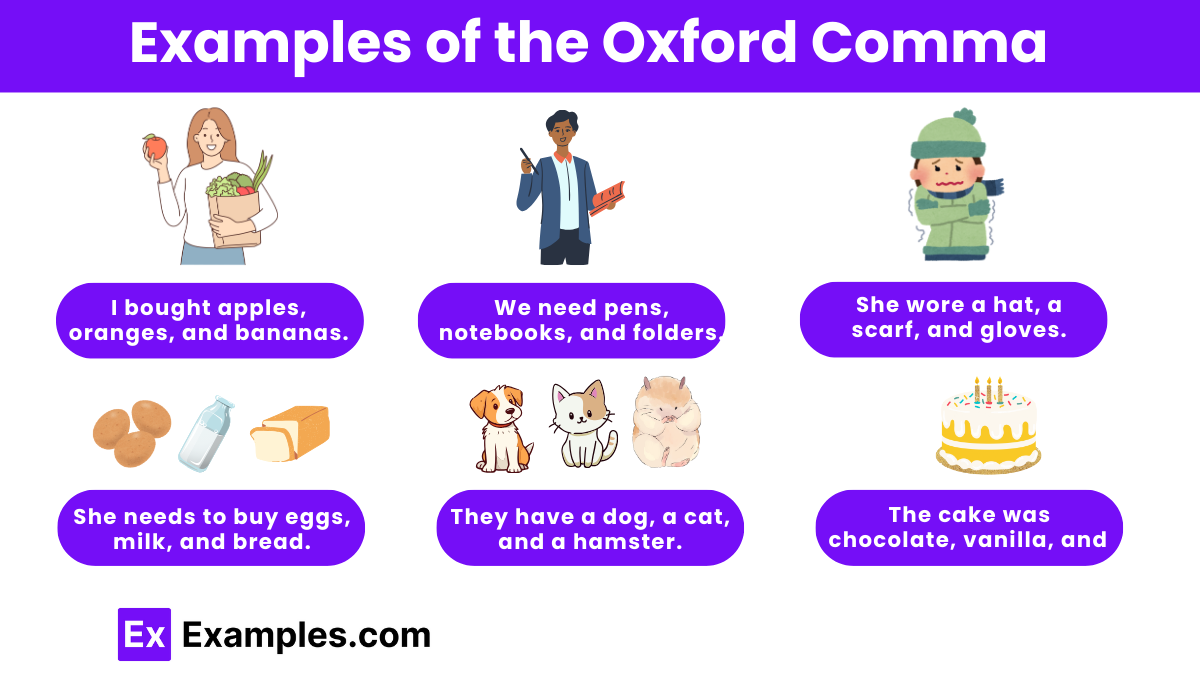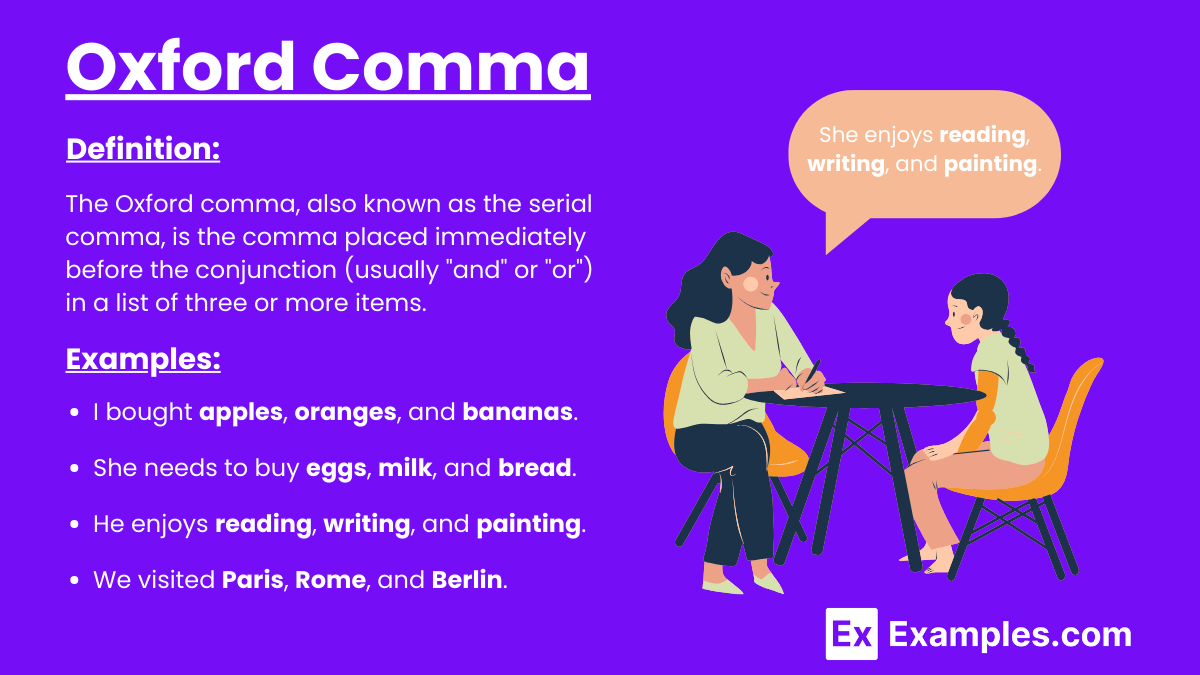55+ Oxford Comma Examples
The Oxford comma, also known as the serial comma, is the comma placed immediately before the conjunction (usually “and” or “or”) in a series of three or more items. For example, in the list “apples, oranges, and bananas,” the Oxford comma is the one that appears after “oranges.” This punctuation mark helps to clarify the meaning of a sentence by clearly separating each item in the list, thus preventing potential ambiguity. The Oxford comma is particularly favored in American English and is often recommended in formal writing for its role in enhancing clarity.
What is an Oxford Comma?
The Oxford comma, also known as the serial comma, is the comma placed immediately before the conjunction (usually “and” or “or”) in a list of three or more items. For example, in the list “apples, oranges, and bananas,” the Oxford comma is the one after “oranges.” Its use clarifies the separation between items, preventing possible misunderstandings.
Examples of the Oxford Comma

- I bought apples, oranges, and bananas.
- She needs to buy eggs, milk, and bread.
- He enjoys reading, writing, and painting.
- We visited Paris, Rome, and Berlin.
- They have a dog, a cat, and a hamster.
- She likes hiking, biking, and swimming.
- He has a red car, a blue bike, and a green scooter.
- The cake was chocolate, vanilla, and strawberry.
- He ordered a burger, fries, and a soda.
- She loves classical music, jazz, and pop.
- The meeting included teachers, students, and parents.
- We need pens, notebooks, and folders.
- She wore a hat, a scarf, and gloves.
- The salad had lettuce, tomatoes, and cucumbers.
- He enjoys fishing, camping, and kayaking.
- She bought a shirt, a dress, and a pair of pants.
- The room was decorated with balloons, streamers, and lights.
- He has visited France, Spain, and Portugal.
- She likes strawberries, blueberries, and raspberries.
- The concert featured rock, country, and blues.
- He ordered spaghetti, lasagna, and ravioli.
- She bought a new phone, a charger, and a case.
- The menu includes pizza, pasta, and salad.
- He studied biology, chemistry, and physics.
- She has seen the movies Star Wars, Lord of the Rings, and Harry Potter.
- The package contains a book, a bookmark, and a pen.
- He likes reading novels, watching movies, and playing video games.
- The dog, the cat, and the rabbit are all pets.
- She has traveled to Canada, Mexico, and Brazil.
- The recipe calls for flour, sugar, and butter.
Oxford Comma Examples Funny
- With Oxford Comma: I’d like to thank my parents, Oprah, and God.
Without Oxford Comma: I’d like to thank my parents, Oprah and God. - With Oxford Comma: We invited the strippers, JFK, and Stalin.
Without Oxford Comma: We invited the strippers, JFK and Stalin. - With Oxford Comma: This book is dedicated to my roommates, Mark, and Ann.
Without Oxford Comma: This book is dedicated to my roommates, Mark and Ann. - With Oxford Comma: On my trip, I saw lions, tigers, and bears.
Without Oxford Comma: On my trip, I saw lions, tigers and bears. - With Oxford Comma: We met the inspiring leaders, Nelson Mandela, and Mother Teresa.
Without Oxford Comma: We met the inspiring leaders, Nelson Mandela and Mother Teresa. - With Oxford Comma: My heroes are my parents, Superman, and Wonder Woman.
Without Oxford Comma: My heroes are my parents, Superman and Wonder Woman. - With Oxford Comma: For breakfast, I enjoy coffee, toast, and cereal.
Without Oxford Comma: For breakfast, I enjoy coffee, toast and cereal. - With Oxford Comma: We saw a movie about a mermaid, a dragon, and a wizard.
Without Oxford Comma: We saw a movie about a mermaid, a dragon and a wizard. - With Oxford Comma: I love my cats, Lady, and Tramp.
Without Oxford Comma: I love my cats, Lady and Tramp. - With Oxford Comma: The recipe calls for salt, pepper, and basil.
Without Oxford Comma: The recipe calls for salt, pepper and basil. - With Oxford Comma: For the picnic, we packed sandwiches, chips, and drinks.
Without Oxford Comma: For the picnic, we packed sandwiches, chips and drinks. - With Oxford Comma: She loves dancing, singing, and painting.
Without Oxford Comma: She loves dancing, singing and painting. - With Oxford Comma: My favorite colors are red, blue, and green.
Without Oxford Comma: My favorite colors are red, blue and green. - With Oxford Comma: We had pizza, salad, and dessert for dinner.
Without Oxford Comma: We had pizza, salad and dessert for dinner. - With Oxford Comma: The book features pirates, zombies, and robots.
Without Oxford Comma: The book features pirates, zombies and robots.
Oxford Comma vs Harvard Comma
| Aspect | Oxford Comma | Harvard Comma |
|---|---|---|
| Definition | A comma placed before the final conjunction in a list of three or more items. | Identical to the Oxford comma, used before the final conjunction in a list of three or more items. |
| Origin | Named after the Oxford University Press, where it was traditionally used. | Named after Harvard University, reflecting its usage in American English and academic writing. |
| Usage in Lists | Enhances clarity by separating each item distinctly. | Enhances clarity by separating each item distinctly, similar to the Oxford comma. |
| Example Sentence | I had eggs, toast, and juice. | I had eggs, toast, and juice. |
| Common Style Guides | Chicago Manual of Style, APA Style. | Often referenced in American academic writing, similar to the Oxford comma. |
| Purpose | To avoid ambiguity and ensure clarity in lists. | To avoid ambiguity and ensure clarity in lists, same as the Oxford comma. |
| Regional Preference | More commonly used in British and American English. | Predominantly used in American English, especially in academic contexts. |
Pros and cons of the Oxford comma
Pros:
- Clarity: Ensures clear separation between items in a list.
- Reduces Ambiguity: Prevents misinterpretation of grouped items.
- Consistency: Maintains uniformity in writing lists.
- Professionalism: Preferred in academic and professional writing for precision.
- Avoids Miscommunication: Reduces risk of misunderstanding in complex lists.
Cons:
- Redundancy: Some view it as unnecessary and adding extra punctuation.
- Style Preferences: Not all style guides require or recommend its use.
- Aesthetic Concerns: Can disrupt the flow or simplicity of a sentence.
- Simplicity: Omitting it can make sentences appear cleaner and simpler.
- Regional Differences: Usage varies, with American English more inclined towards its use compared to British English.
Lists with semicolons instead of commas
Using semicolons in lists can be useful when the items in the list are complex or contain commas themselves. Here’s how to structure lists with semicolons instead of commas:
Example 1: Complex Items in a List
When list items are lengthy or contain internal punctuation, use semicolons to separate them:
Incorrect:
- For our vacation, we visited Paris, France, Rome, Italy, and Barcelona, Spain.
Correct:
- For our vacation, we visited Paris, France; Rome, Italy; and Barcelona, Spain.
Example 2: Descriptive List Items
If each list item includes additional descriptive information that would make using commas confusing:
Incorrect:
- On our trip, we saw the Eiffel Tower, a stunning example of French architecture, the Colosseum, an ancient Roman amphitheater, and the Sagrada Família, a magnificent basilica in Barcelona.
Correct:
- On our trip, we saw the Eiffel Tower, a stunning example of French architecture; the Colosseum, an ancient Roman amphitheater; and the Sagrada Família, a magnificent basilica in Barcelona.
Example 3: List Items with Multiple Commas
When items themselves contain commas, semicolons help clarify the separation between them:
Incorrect:
- Our conference speakers include Dr. Jane Smith, Professor of Biology, University of Cambridge, Dr. John Doe, Director of Research, National Health Institute, and Dr. Alice Johnson, Senior Scientist, Global Health Organization.
Correct:
- Our conference speakers include Dr. Jane Smith, Professor of Biology, University of Cambridge; Dr. John Doe, Director of Research, National Health Institute; and Dr. Alice Johnson, Senior Scientist, Global Health Organization.
Why is it called the Oxford Comma
The Oxford comma, also known as the serial comma, is named after the Oxford University Press, where it was traditionally used in their publications. This punctuation mark is placed before the conjunction (usually “and” or “or”) in a list of three or more items. For example: “apples, oranges, and bananas.”
Origin and Usage
- Oxford University Press: The term “Oxford comma” originated from the Oxford University Press, a prestigious academic publisher that consistently used this comma in its style guides and publications.
- Clarity and Precision: The primary reason for using the Oxford comma is to enhance clarity and avoid ambiguity in sentences. By placing a comma before the final conjunction, writers can ensure that each item in a list is distinctly separated.
FAQs
Is the Oxford comma necessary?
It’s often a stylistic choice. Some style guides recommend it for clarity, while others do not require it.
When should I use the Oxford comma?
Use the Oxford comma when you want to prevent ambiguity in a list.
Can the Oxford comma change the meaning of a sentence?
Yes, using or omitting it can change the meaning, especially in complex lists.
What’s an example of the Oxford comma providing clarity?
Without the Oxford comma: “I love my parents, Lady Gaga and Humpty Dumpty.” With it: “I love my parents, Lady Gaga, and Humpty Dumpty.”
Which style guides require the Oxford comma?
The Chicago Manual of Style and APA Style both require the Oxford comma.
Which style guides do not require the Oxford comma?
The Associated Press (AP) Stylebook does not require the Oxford comma.
Can I use the Oxford comma in informal writing?
Yes, you can use it in both formal and informal writing based on your preference.
Is the Oxford comma used in British English?
British English tends to omit the Oxford comma more often than American English.
Does omitting the Oxford comma always cause confusion?
No, omitting it doesn’t always cause confusion, but it can in certain cases.
Should I use the Oxford comma in academic writing?
Yes, especially if following a style guide that recommends it, like APA or Chicago.



